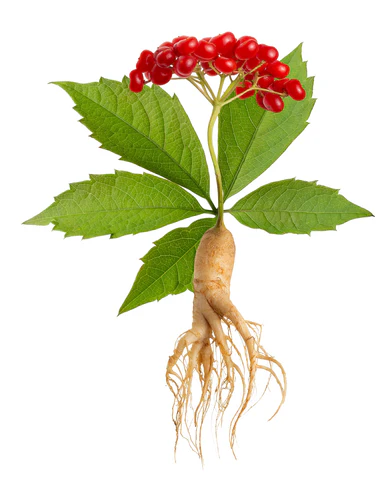Common Ginseng
Common Ginseng
Panax ginseng C.A.Mey.
Family — Araliaceae
Ginseng Description
Common Ginseng is a perennial herbaceous plant, 30–70 cm tall, with a single stem and a fleshy root (up to 20 cm long, 2–3 cm thick), often resembling a human figure. Leaves are palmately compound, 10–20 cm, with 3–5 green, serrated leaflets. Flowers are small, greenish-white, 2–3 mm, gathered in umbellate inflorescences (5–20 flowers). Fruits are red berries, 5–7 mm, with 2–3 seeds. Varieties: 'Red Ginseng', 'Korean Ginseng', 'Wild Ginseng', 'American Ginseng' (Panax quinquefolius), 'Siberian Ginseng' (Eleutherococcus senticosus). Flowering occurs in June–July, fruiting in August–September.
Habitat and Ecology of Ginseng
Ginseng's homeland is the Russian Far East, China, Korea. It grows in coniferous-broadleaf forests, on slopes, up to 700 m above sea level. It is cultivated in China, Korea, Japan, Russia (Primorsky Krai). It prefers loose, humus-rich soils (pH 5.5–6.5), shade, and watering with 5–10 l/m² once every 7–10 days. Propagates by seeds and root cuttings. Yield: 100–200 g of root/m² (after 5–7 years). Care: mulching, organic fertilization (10–15 g/m²), protection from fungi and slugs. Used in reforestation, as an ornamental plant.
Ginseng Raw Materials
Raw materials: roots (radix Ginseng), leaves (folia Ginseng). Roots are harvested in autumn (September–October) in the 5th–7th year of life, dried at 50–60 °C (yield 20–25 %) or used fresh. Leaves are harvested in June–July, dried at 40 °C (yield 15–20 %). Quality: roots — yellowish-white, mold-free; leaves — green; moisture ≤12 %. Store in airtight containers (roots: 3 years; leaves: 1 year). Specific odor, bitter-sweet taste.
Chemical Composition of Ginseng
Roots: ginsenosides (up to 6 %), polysaccharides (up to 20 %), essential oil (up to 0.2 %), sterols, phenolic compounds, vitamins (C, B1, B2), minerals (K, Ca, Fe). Leaves: ginsenosides (up to 3 %), flavonoids, tannins (up to 2 %). Fruits: sugars (up to 5 %), vitamin C (up to 50 mg%). Caloric content of roots: 40–50 kcal/100 g.
Action and Application of Ginseng
Ginseng has adaptogenic, tonic, immunostimulating, antioxidant, and hypoglycemic effects. It is used for fatigue, stress, reduced immunity, hypotension, impotence, diabetes, and neuroses. Roots increase efficiency, improve memory, and normalize blood pressure. Leaves help with colds and skin inflammations. Ginseng preparations stimulate the nervous system and improve blood circulation.
Precautions for Ginseng Use
Consumption of >5 g/day of roots or >50 ml/day of tincture can cause insomnia, tachycardia, and headache. Store tinctures at 0–5 °C for no longer than 1 month. Not recommended for children under 12 years old. Avoid combination with caffeine (increased stimulation). Long-term use (>2 months) requires a break (1 month). Carefully check raw materials for pesticides.
Contraindications for Ginseng Use
Allergy to Araliaceae, hypertension, tachycardia, insomnia, epilepsy, pregnancy, lactation, age under 12 years.
Ginseng Recipes
- Root Tincture for Tonic Effect. Pour 100 ml of 40% alcohol over 10 g of roots, infuse for 20 days, drink 10 drops twice a day for 14 days.
- Root Decoction for Fatigue. Boil 5 g of roots in 200 ml of water for 15 minutes, drink 50 ml twice a day for 10 days.
- Leaf Infusion for Colds. Pour 200 ml of boiling water over 10 g of leaves, steep for 20 minutes, drink 50 ml twice a day for 7 days.
- Poultice for Skin Inflammations. Pour 100 ml of boiling water over 10 g of leaves, steep for 20 minutes, apply for 15 minutes, twice a day for 5 days.
- Ginseng Honey Elixir. Finely slice 5g of fresh ginseng root and steep in 250ml of warm honey for 1 week. Take a spoonful daily for general well-being.
- Ginseng and Ginger Tea. Simmer 3g of dried ginseng slices and a few slices of fresh ginger in 500ml of water for 20 minutes. Strain and sweeten with honey to taste.
Ginseng Cosmetics
Ginseng is used for skin and hair care.
- Rejuvenating Mask. Mix 5 g of root powder, 10 ml of honey, 10 ml of water, apply for 15 minutes, rinse, twice a week.
- Toning Lotion. Mix 10 ml of root infusion with 10 ml of water, wipe the skin once a day.
- Hair Mask. Mix 5 g of root powder with 10 ml of olive oil, apply to hair for 20 minutes, rinse, once a week.
- Leaf Infusion for Acne. Pour 100 ml of boiling water over 10 g of leaves, steep for 20 minutes, wipe the skin twice a day.
- Ginseng Face Serum. Combine 5ml of ginseng root extract with 20ml of rosehip oil and 5 drops of frankincense essential oil. Apply a few drops to the face and neck daily.
- Ginseng Scalp Treatment. Mix 10ml of ginseng root tincture with 30ml of jojoba oil. Massage into the scalp, leave for 30 minutes, then shampoo as usual.
Ginseng Culinary
Roots are used in teas, soups, tinctures.
- Root Tea. Pour 200 ml of boiling water over 3 g of dried roots, steep for 10 minutes.
- Tincture for Drinks. Pour 200 ml of 40% alcohol over 10 g of roots, infuse for 20 days, add 5 ml to tea.
- Ginseng Soup. Boil 5 g of roots in 500 ml of chicken broth for 20 minutes, serve with herbs.
- Powder for Smoothies. Blend 2 g of root powder, 200 g of fruit, 100 ml of yogurt in a blender.
- Ginseng Chicken Porridge (Congee). Add thin slices of ginseng root to a slow-cooked chicken and rice porridge for a nourishing meal.
- Ginseng Infused Rice. Add a few thin slices of ginseng root to your rice cooker with the water before cooking for subtly flavored and healthful rice.
Tips: Store fresh roots at 0–5 °C for up to 6 months, dried roots for up to 3 years. Use in small doses due to its potent effects.
Other Properties of Ginseng
Used in ornamental landscaping, as a honey plant.




